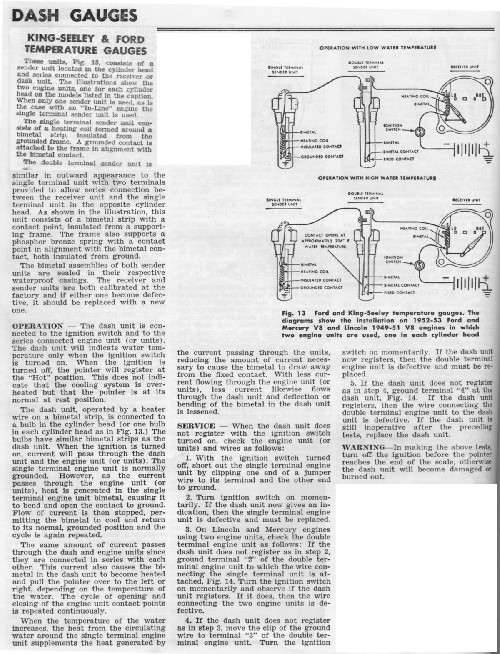|
Re: Temp sending Unit
|
||||
|---|---|---|---|---|
|
Home away from home

|
Did you look at the TS6164 from NAPA ? Max Merritt has your for 1950 $100.00 !!!!! I'll keep looking
What year is your car?
Posted on: 2011/1/23 19:06
|
|||
|
||||
|
Re: Temp sending Unit
|
||||
|---|---|---|---|---|
|
Home away from home

|
Did you look at Advance auto part Sunpro CP7576
Posted on: 2011/1/23 19:42
|
|||
|
||||
|
Re: Temp sending Unit
|
||||
|---|---|---|---|---|
|
Home away from home
|
Am i reading correctly that the ford type doesn't vary resistance with temp, it somehow switches on and off inside?
If it does do resistance but in a different way, ohms are ohms no matter how you do the resisting. I guess i'd have to find the ohms rating for the 50 if it IS that type and try to find one in that range that fits those threads. If it is a different "signal" to the gauge, then maybe i can find those specs and fine one of the smaller thread size. Walkerman: Thanks for the links! My 50 sender (and presumably the 53 sender) are both good, but i'm afraid the 53 sender in the 53 motor connected to the 50 dash gauge might not work or damage the gauge. I just restored the entire dash, i know it's a pain to get that gauge out. So i don't need a replacement sender per se; i need a sender that's the same as the 50 but will fit in the smaller hole, which might not be possible. I hate to drill out the head and thread it, because i might mess it up freehand.
Posted on: 2011/1/23 20:44
|
|||
|
||||
|
Re: Temp sending Unit
|
||||
|---|---|---|---|---|
|
Home away from home

|
Before I would drill out the head I would bite the bullet and pay the $100.00 and buy it from Max Merritt. You can try some of the other places Packard Tucson,etc.
Good Luck.
Posted on: 2011/1/23 20:52
|
|||
|
||||
|
Re: Temp sending Unit
|
||||
|---|---|---|---|---|
|
Home away from home
|
That's the problem, though. If i buy it from MM, they'd ship me a 50 sending unit, with threads and temp reading end, that are too big to fit into the hole on the 53 head. If i leave the 53 sending unit it, it doesn't look as if it'll be compatible with the gauge in the 50 car.
I have a working 50 sending unit just like MM is selling, and it works with the gauge in the car...just won't fit in the newer motors head.
Posted on: 2011/1/23 21:08
|
|||
|
||||
|
Re: Temp sending Unit
|
||||
|---|---|---|---|---|
|
Forum Ambassador
|
The resistance in the sender you are reading is the heater wire. You are correct in that it is an on/off cycle. Works exactly the same way the instrument voltage regulator does on the later units.
When on, both heaters are in series and start to heat. The bimetal in gauge begins to move and the bimetal in the sender does also. At a point the sender bends enough to open the contact and both units cool down. Gauge moves slowly in reverse a tiny bit when sender opens but as it moves slowly, the movement is almost not seen. Sender cools down too, cycles and re establishes contact and starts heating again. This on/off repeats at a rate until gauge reads the actual temp and stabilizes. At that point its a rapid on/off to keep the needle almost immobile. As the engine heats, it also acts on the bimetal and changes the cycle time which is reflected in the gauge reading. Gas gauge is also similar in operation except the float works a mechanical cam which applies force against that bimetal and changes cycle rate. That off cycle is the part I don't know about. Maybe you could heat some water to about 160 degrees. Hook up the 53 sender and watch the needle. If it goes to mid point or appropriate area and stays, maybe it would work. If it keeps trying to move past that point, disconnect it before any damage occurs.
Posted on: 2011/1/23 21:09
|
|||
|
Howard
|
||||
|
||||
|
Re: Temp sending Unit
|
||||
|---|---|---|---|---|
|
Home away from home
|
The water idea is brilliant, and i feel like a fool for not trying it...will tomorrow!
Posted on: 2011/1/23 22:59
|
|||
|
||||
|
Re: Temp sending Unit
|
||||
|---|---|---|---|---|
|
Home away from home

|
I don't know if the water will work I think the sender needs to be grounded to engine not sure, you might have to put wire from top of sender to block if it does't work without one
Posted on: 2011/1/24 6:46
|
|||
|
||||
|
Re: Temp sending Unit
|
||||
|---|---|---|---|---|
|
Home away from home
|
Another valid point. I won't get to it until after work tonight, but i'll try exactly that. Maybe i'll get the water to 200, and then i'll know exactly where on the dash gauge 200 is in case it's different than before.
This will be good data to have for everyone, knowing if these parts are compatible or not.
Posted on: 2011/1/24 9:26
|
|||
|
||||

 (267.56 KB)
(267.56 KB)







